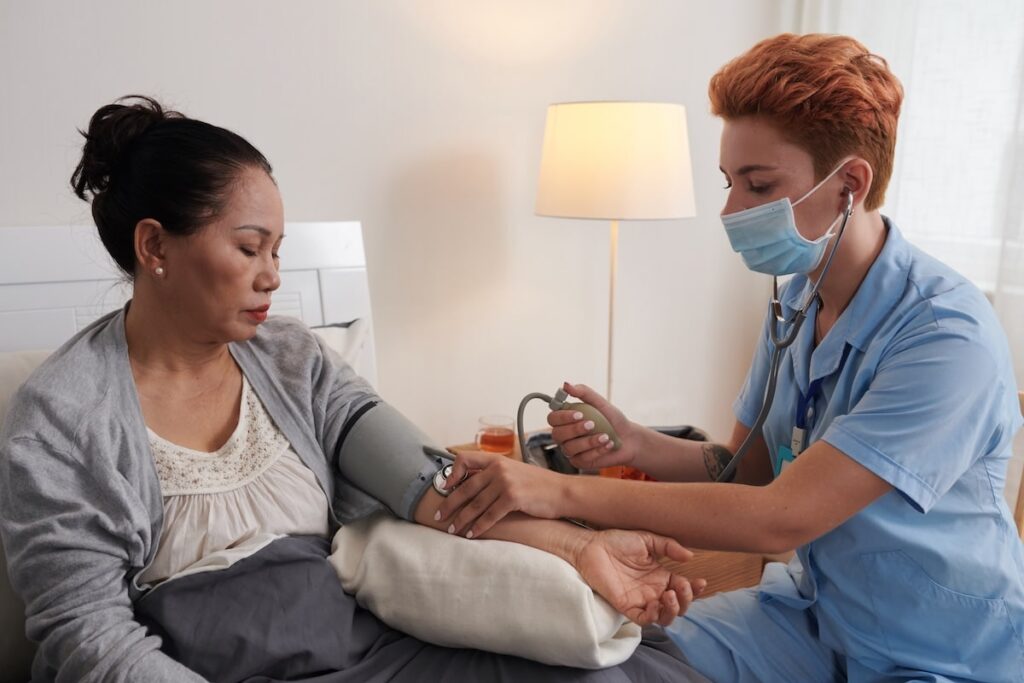
With over 1.47 million CNAs nationwide and 216,200 new job openings projected annually through 2033, certified nursing assistants represent one of healthcare’s most vital and misunderstood professions. If you’ve been researching healthcare careers, you’ve probably noticed a lot of confusion about what CNAs actually do and how they differ from similar roles.
As someone who worked as a CNA before transitioning into healthcare education, I’ve been exactly where you are now. I remember wondering whether becoming a CNA was the right choice, what the work would be like, and how it compared to other healthcare careers. That uncertainty is entirely standard.
“I’m confused about being called a CNA vs a PCA. Do you find them to be the same?”
This question perfectly captures the confusion many people feel when researching healthcare careers. You’re not alone in feeling overwhelmed by healthcare titles and job descriptions.
By the end of this guide, you’ll understand:
- What CNAs actually do day-to-day
- How the role differs from similar positions
- What to expect in different workplace settings
- Whether this career path aligns with your goals
Let me walk you through everything you need to know about becoming a CNA, drawing from professional healthcare research and the real experiences of CNAs working in the field today.
What Does CNA Stand For? And Why It Gets Confusing
CNA stands for Certified Nursing Assistant, though you might also see it written as Certified Nurse Aide. Both terms refer to the same profession. Think of CNAs as the healthcare team members who provide hands-on, personal care to patients under the supervision of licensed nurses.
Why All the Different Titles?
Here’s where it gets confusing: different states and healthcare facilities sometimes use different titles for essentially the same role:
- PCA (Patient Care Assistant)
- Nursing Assistant
- Nurse Aide
- Patient Care Technician
While there can be slight differences in responsibilities, they’re all part of the same family of direct-care healthcare positions.
The confusion gets even deeper when you consider that some states have their own specific titles. Don’t worry, we’ll clear this up as we go through this guide.
The critical thing to understand: A CNA is your entry point into hands-on patient care, and it’s a role that puts you right at the heart of helping people during some of their most vulnerable moments.
What CNAs Actually Do: Your Day-to-Day Reality
Let me paint you a picture of what CNA work looks like, because the job descriptions you’ll find online often don’t capture the whole reality of this role.
Core CNA Responsibilities Every Day

As a CNA, you’re the healthcare team member who spends the most time directly with patients. Your work revolves around activities of daily living (ADLs). These are the fundamental things people need help with when they’re sick, injured, or elderly.
Your daily responsibilities include:
- Helping patients bathe, dress, and use the bathroom
- Assisting with meals, making sure patients eat and drink enough, while documenting their intake
- Taking vital signs like blood pressure, temperature, and pulse, then recording these in patient charts
- Helping patients move from their bed to a wheelchair or to different areas of the facility
Behind-the-scenes work:
- Cleaning and preparing patient rooms
- Stocking medical supplies
- Maintaining equipment
- Being the person patients call when they need help
You’re often their primary source of comfort and reassurance.
That learning curve is real – I remember feeling completely overwhelmed as a new CN during the first few months. Every experienced CNA I know has the same story. You’ll question whether you’re cut out for this work, wonder if you’re helping patients enough, and feel exhausted by the physical and emotional demands. But it gets easier as you build confidence and develop your skills.
What you cannot do as a CNA:
- Administer medications (except in particular circumstances with additional training)
- Perform clinical assessments
- Carry out invasive medical procedures
You work under the supervision of licensed nurses, and state regulations clearly define your scope of practice.
A Real Day in the Life of a Hospital CNA

Hospital CNA work moves at a pace different from other healthcare settings. Here’s what a typical 12-hour day shift looks like:
7:00–7:30 am: Shift Report and Setup
- Get a report from the night shift about your 8-12 assigned patients
- Learn who had difficult nights, scheduled procedures, and patients needing extra attention
7:30–11:00 am: Morning Care Rush (Your busiest time)
- Help patients wash up, get dressed, and eat breakfast
- Take morning vital signs and document everything
- Handle patients cleared to eat after being NPO (nothing by mouth) overnight
11:00–12:00 pm: Mid-Morning Tasks
- Transport patients to and from procedures
- Help with position changes for bedbound patients
- Respond to call lights
- Take a short break if staffing allows
12:00–2:00 pm: Lunch and Afternoon Care
- Provide lunch assistance and more vital signs
- Continue patient care
- Deal with unexpected situations (something always comes up in hospitals)
2:00–3:00 pm: Documentation and Handoff
- Complete documentation for the day
- Report to the evening shift about each patient’s status
The Reality: Hospital CNA work is intense. You’re dealing with acutely ill patients, fast-paced environments, and often inadequate staffing. Patient ratios typically run about 1 CNA to 5 patients in states like New York, but this varies significantly.
A Real Day in the Life of a Nursing Home CNA
Nursing home CNA work has an entirely different rhythm:
Key Differences:
- 8-hour shifts instead of 12-hour shifts
- 15-20 residents per CNA (varies by state)
- Build relationships with the same people over months/years
7:00–7:30 am: Gentle Morning Start
- Check on your residents (you know them personally)
- Mrs. Johnson needs her coffee first, and Mr. Peterson wants weekend updates
7:30–11:00 am: Personal Care Time
- Help with morning routines: bathing, dressing, grooming
- Get residents ready for breakfast
- Takes longer than hospital care – you have time to be thorough
11:00 a12:00 pm0pm: Activities and Social Time
- Help residents participate in crafts, games, and social events
- One of the more rewarding aspects – seeing residents enjoy themselves
12:00–2:00 pm: Lunch and Rest Time
- Provide meal assistance (many residents need help eating)
- Meals are social times that residents look forward to
2:00–3:00 pm: Afternoon Care and Documentation
- Continue personal care
- Complete documentation and prepare for the evening shift
The emotional reality of nursing home work is different, too. While the work is demanding and often undervalued, many CNAs find deep satisfaction in the relationships they build and the comfort they provide.
CNA Specialization Opportunities
Many people don’t realize that CNAs can specialize in different areas that often come with higher pay and more focused responsibilities.
Critical Care/ICU CNAs
- Work with the sickest patients in hospitals
- Require additional training
- Offer premium pay above base CNA salary
Pediatric CNAs – $37,085 annually
- Specializing in caring for children
- Need an understanding of child development
- Work with scared children and anxious parents
Surgical CNAs
- Focus on pre-operative and post-operative care
- Learn about surgical procedures and recovery
- Command higher pay than general positions
Telemetry CNAs
- Work with cardiac monitoring patients
- Require specialized equipment training
- Premium rates for technical skills
Geriatric CNAs – $34,744 annually
- Specializing in elderly care
- High-demand field with job security
Skills that command higher pay across all CNA specializations include telemetry monitoring, rehabilitation assistance, palliative care knowledge, and ICU protocols. The career progression follows this path: entry-level CNA, specialized CNA, and advanced roles like LPN or RN.
CNA vs Everything Else: Clearing Up the Confusion
This is where I want to clear up the confusion plaguing everyone researching healthcare careers. The differences between CNAs, PCTs, Medical Assistants, and LVNs are significant, and understanding them will help you choose the right path for your situation.
Healthcare Support Roles Comparison
Understanding the key differences between CNA, PCT, MA, and LVN positions
- Hospitals
- Nursing homes
- Assisted living
- Home health
- Hospitals (primary)
- Acute care units
- Specialty departments
- Clinics
- Doctor’s offices
- Outpatient facilities
- All healthcare settings
- Hospitals
- Nursing facilities
- Clinics
CNA vs PCT: What’s the Real Difference?
Patient Care Technicians (PCTs) are essentially CNAs with additional technical training.
Key Differences:
Training Requirements:
- CNAs: 1-4 months through state-approved programs
- PCTs: 2-12 months (many require CNA certification first)
Salary Comparison:
- CNAs: $39,530 median annually
- PCTs: $38,130 median (but often work in higher-paying hospitals)
Skills and Responsibilities:
- CNAs: Basic patient care (bathing, feeding, vital signs, comfort measures)
- PCTs: Everything CNAs do PLUS phlebotomy, EKGs, complex medical procedures
Work Settings:
- CNAs: Everywhere (hospitals, nursing homes, assisted living, home health)
- PCTs: Primarily hospitals where technical skills are most needed
The Bottom Line: PCTs are specialized CNAs, and the roles overlap significantly in many facilities.
CNA vs Medical Assistant: Different Paths Entirely
Medical Assistants (MAs) and CNAs work in completely different environments.
Key Differences:
Work Settings:
- CNAs: Hospitals, nursing homes, long-term care (direct patient care)
- MAs: Clinics, doctors’ offices, outpatient facilities (clinical + administrative)
Daily Responsibilities:
- CNAs: Hands-on patient care, intimate personal assistance with daily living
- MAs: Split time between clinical tasks and administrative work (scheduling, records, insurance)
Training and Pay:
- CNAs: 1-4 months training, $39,530 median salary
- MAs: 6 months to 2 years, $44,200 median salary
Career Paths:
- CNAs: Often a stepping stone to nursing school
- MAs: Advance to office management or medical billing/coding
CNA vs LVN/LPN: The Next Step Up
Licensed Vocational Nurses (LVNs) in California/Texas or Licensed Practical Nurses (LPNs) elsewhere represent the next career level.
Major Differences:
Training Requirements:
- CNAs: 1-4 months basic training
- LVN/LPNs: 12-18 months intensive education + clinical practice
Scope of Practice:
- CNAs: Basic patient care under supervision
- LVN/LPNs: Administer medications, clinical assessments, and much more independence
Salary Jump:
- CNAs: $39,530 median
- LVN/LPNs: $62,340 (Nearly $23,000 more annually!)
Career Advantage: Many CNAs use their hands-on experience to excel in LVN/LPN programs.
Why CNAs Have Different Names in Different States
Here’s something that confuses almost everyone: CNAs go by different names in different states, and it’s not just cosmetic. Sometimes the requirements and scope of practice vary, too.
- LVN (Licensed Vocational Nurse) is used in California and Texas. Don’t let the “nurse” title confuse you. California and Texas LVNs perform the same basic functions as CNAs in other states, though California LVNs have a slightly expanded scope of practice.
- STNA (State-Tested Nursing Assistant) is what Ohio calls CNAs. Same job, different name, and you’ll need to be on Ohio’s state registry to work there.
- SRNA is used in some regions, and you might also see variations like GNA (Geriatric Nursing Assistant) or LNA (Licensed Nursing Assistant).
Why did this happen? Healthcare regulation occurs at the state level, and states developed their own terminology and requirements over time. What matters for you is understanding that certification requirements vary by state. If you become certified as a CNA in one state and move to another, you’ll likely need to transfer your certification or meet that state’s specific requirements.
Where CNAs Work: How Different Each Setting Really Is
The setting where you work as a CNA dramatically affects your daily experience, salary, and job satisfaction. Let me give you the real picture of what each environment is actually like.
Hospital CNAs: Higher Pay, Higher Intensity
The Numbers:
- Average salary: $42,210 annually (highest among CNA settings)
- Turnover rate: 41.8% annually
- Patient load: 8-12 patients per shift
What Makes Hospital Work Unique:
- 12-hour shifts that can feel relentless
- Patients with acute medical conditions requiring intensive care
- Fast pace, high stakes, constant variety
- Extensive support from medical teams
- Clear advancement and skill development opportunities
Best for: People who thrive in fast-paced environments and enjoy variety.
Nursing Home CNAs: Building Long-Term Relationships
The Numbers:
- Average salary: $40,220 annually
- Current reality: 88% of facilities report staffing shortages
- Resident load: 15-20 people per CNA (varies by state)
What Makes Nursing Home Work Different:
- Get to know residents as individuals (preferences, families, life stories)
- Support people through end-of-life care
- More routine, less medical crisis management
- Significant physical and emotional demands
- Build genuine connections with residents and families
Best for: Relationship-focused people who prefer routine over constant change.
“I love making people feel better. That’s why I do this!”
This perspective captures why many CNAs choose nursing home work despite the challenges.
Assisted Living and Other Settings
The Numbers:
- Average salary: $35,640 annually (lowest among primary settings)
- Current reality: 77% of facilities are experiencing staffing difficulties
- Focus: More social, less medical intensity
What Makes Assisted Living Work Different:
- Support people who need help but aren’t as medically fragile
- Emphasis on quality of life activities and social interaction
- Less medical crisis management, more independence maintenance
- More predictable routine than hospital settings
- Lighter physical demands than nursing homes
Best for: People who enjoy social interaction and prefer a less medically intensive environment.
“Being a CNA is impossible without a supportive team… this job is impossible without people in your corner.”
This insight highlights the most critical factor in CNA job satisfaction – workplace culture and team support can make or break your experience.
The Real Challenges CNAs Face and How to Prepare
I want to be completely honest with you about the challenges you’ll face as a CNA, because understanding these realities upfront helps you prepare mentally and decide if this career is right for you.
Physical Demands and Injury Prevention
The Sobering Statistics:
- 60% of nursing home CNAs report job-related injuries annually
- Hospital CNAs have twice the injury rate of average workers
Most Common Injuries:
- Back problems from lifting and repositioning patients
- Overexertion injuries
- Slip and fall accidents
- Occasional injuries from patient interactions
The Reality Check: CNA work involves all aspects of human bodily functions. Most CNAs adapt quickly, but you’ll be helping people with very personal and sometimes unpleasant care needs.
Prevention Strategies That Work:
- Proper body mechanics training
- Use lifting equipment whenever available
- Wearing appropriate protective gear
- Speaking up when you need help with difficult transfers
Emotional Challenges and Burnout
The Statistics: 81% of nurses report burnout experiences, and CNAs face similar rates.
What Causes Emotional Stress:
- Caring for sick, frightened, or dying people
- Workplace stress and inadequate staffing
- Steep learning curve for new CNAs
- Feeling overwhelmed by physical and emotional demands
Coping Strategies Successful CNAs Use:
- Find meaning in small moments of patient connection
- Build supportive relationships with coworkers
- Set boundaries between work and personal life
- Recognize you can’t fix everything for everyone
The Balance: Many CNAs find that meaningful aspects (helping someone feel comfortable, being there during difficult moments, seeing patients recover) provide enough emotional reward to balance the challenges.
Workplace Realities You Should Know
Currently, 88% of nursing facilities are affected by staffing shortages. This means you’ll often be asked to work with higher patient loads than ideal, and mandatory overtime is common in many facilities.
You’ll work holidays, weekends, and nights. Healthcare happens 24/7, and CNAs are essential to that continuity of care.
But there are career advancement opportunities. The progression typically goes from entry-level CNA Specialized CNA,n to advanced roles like LPN or RN. Many CNAs use their experience as a foundation for further healthcare education.
What supportive workplaces provide includes adequate staffing levels, opportunities for professional growth, recognition programs, and management that listens to CNA input about patient care.
Seek out workplaces that prioritize staff support and patient safety. The right workplace culture makes all the difference in your job satisfaction and career success.
Check Your CNA Eligibility in 30 Seconds
Is Being a CNA Right for You? Honest Self-Assessment
After working as a CNA and now helping people explore healthcare careers, I’ve learned that certain personality traits and preferences tend to predict CNA job satisfaction. Let me help you honestly assess whether this career aligns with who you are.
Essential CNA Qualities
Must-Have Traits:
- Compassion and patience – Work with scared, confused, or frustrated people; remain kind even when patients are difficult
- Physical stamina – Long shifts on your feet doing physical work
- Emotional resilience – Manage stress while caring for vulnerable people
- Strong communication – Link between patients and healthcare team; listen carefully, document accurately
- Team player mentality – Healthcare is collaborative; CNAs who struggle with teamwork struggle in jobs
- Comfort with intimate care – Help with bathing, toileting, dressing; if this makes you uncomfortable, CNA work will be difficult
Red Flags: Signs CNA Work Might Not Fit
Be honest about these potential issues:
- Strongly motivated by high pay – Work is meaningful, but not highly compensated relative to demands
- Prefer working independently – CNA role involves direct supervision and following specific protocols
- Uncomfortable with healthcare realities – Bodily functions, medical equipment, illness, death
- Need predictable schedules – Healthcare’s 24/7 nature and shift work will be challenging
Remember: Discovering healthcare isn’t for you; it is valuable information, not a failure. Better to learn this early than after a significant investment.
How to Test Your Interest Before Committing
Consider volunteering at hospitals, nursing homes, or assisted living facilities to get exposure to the environment and patient population.
Shadow a working CNA for a day if possible. Many facilities will arrange this if you’re considering their CNA training program.
Talk to CNAs working in different settings about their experiences. Most CNAs are happy to share honest perspectives about their work.
Consider your motivations carefully. Good reasons to become a CNA include wanting to help people, having an interest in healthcare, having a desire for job security, and viewing it as a stepping stone to other healthcare careers. Poor reasons include thinking it’s “easy” work or assuming it requires no skills or training.
Your Next Steps to CNA Success

If you’re excited about becoming a CNA, that’s a great sign. You now have a realistic picture of what the work involves.
Recommended Action Steps
1. Research CNA Training Programs
- Requirements vary by location
- Look for state-approved programs
- Check job placement rates and student reviews
2. Connect with Local Healthcare Facilities
- Learn about CNA positions available
- Ask about pay rates and work culture
- Many facilities are actively recruiting CNAs
3. Consider Your Personal Circumstances
- Can you handle training program requirements?
- Are you prepared for shift work demands?
- Do you need emotional and physical stamina?
4. Remember, This is Often Just the Beginning
- Many CNAs advance to LPNs, RNs, or other specializations
- Patient care experience is invaluable for advanced healthcare roles
Why Your Decision Matters
As someone who started as a CNA and moved into healthcare education, the skills you develop serve you well throughout your healthcare career:
Skills You’ll Gain:
- Patient advocacy
- Clinical observation
- Teamwork
- Compassion
The Need is Real:
- 216,200 job openings projected annually
- An aging population requiring more care
- CNAs play an essential role in the healthcare system
Whether you’re 18, starting your first career, or 45, looking for meaningful change, CNA work can provide a foundation for a stable, purposeful career helping others during their most vulnerable moments.
Take your time making this decision, but don’t let fear hold you back if this feels right.
The healthcare field and the patients who need your care will benefit from dedicated people like you choosing this path. Ready to explore CNA training programs in your area?